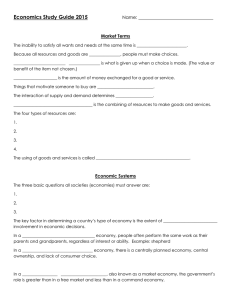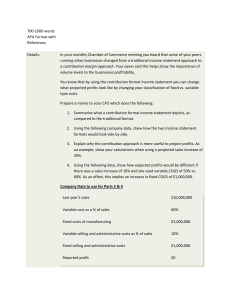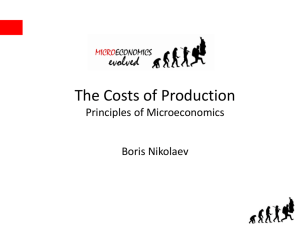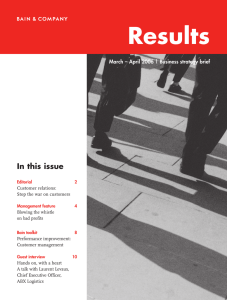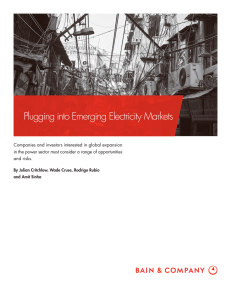2014 BBD-U - Kenneth Wong's Presentation
advertisement
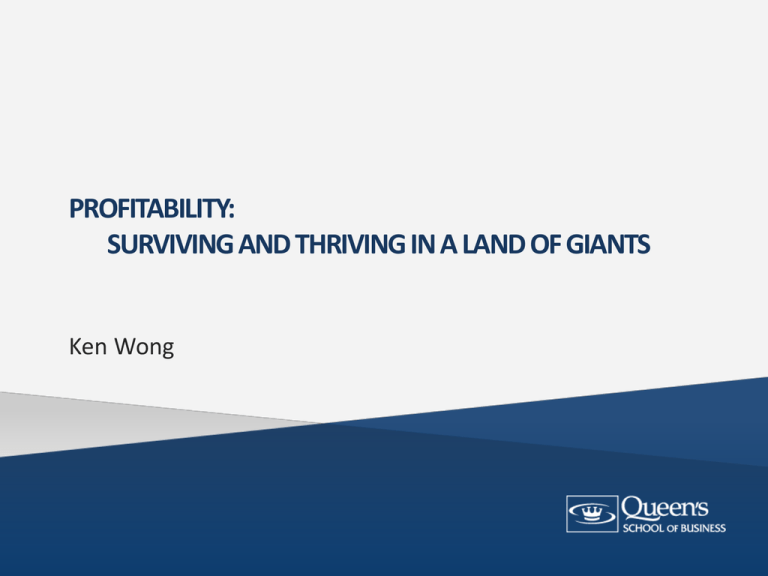
PROFITABILITY: SURVIVING AND THRIVING IN A LAND OF GIANTS Ken Wong Key Number 1: The Right Priority and the REAL Enemy MARGIN-SUCKING MAGGOTS Chasing the WRONG Customers In the WRONG Way For the WRONG Reason 2 Profit: The Scorecard Price Unit Margins Net Income Return On Investment Divided By Assets Managed Minus Cost Times Unit Volumes Market Share Times Market Size 3 A Comparison of Profit Levers A 1% change in... Creates a change in operating profit of ... Price 11.1% Variable Cost Fixed Cost Volume 7.8% 2.3% 3.3% (Average economics of 2,463 businesses in Compustat) Nothing destroys profits FASTER than cutting price • The Tradeoffs Are Significant – Every 1% price cuts requires you to either cut variable costs by 1.34% OR acquire enough new customers to raise volume by 3.4% • Price cuts often lead to an erosion of quality – Price cuts that have an immediate financial impact focus on “shovel-ready” sources of cost reduction that makes differentiation impossible – You cannot “automate” a relationship – Efficiency programs take time to implement • There rarely is enough volume available to offset the cost of acquisition 5 Yes….but CUSTOMERS ALWAYS WANT LOWER PRICES DO WE GIVE THEM THOSE PRICES? HOW DO WE SUSTAIN PROFITABILITY IF WE DO? Value is the RATIO of Quality-to-Price • Four Ways to Enhance Value 1. MAINTAIN QUALITY – REDUCE PRICE 2. REDUCE QUALITY A "LITTLE" – REDUCE PRICE A "LOT" 3. INCREASE QUALITY – MAINTAIN PRICE 4. RAISE QUALITY A "LOT" – RAISE PRICE A "LITTLE" Why We Prefer "Quality-based Value Gains" • Longer strategic window of opportunity/advantage • Greater economic efficiency Some Evidence % chg 3 years post-recovery (SALES; EBITDA) 13.0 12.2 9.4 9.0 7.9 6.6% 6.2% 6.3 6.2 4.4 PREVENTION (cut PRICES then cut COSTS to fiance) PROMOTION (spent heavily) PRAGMATIC PROGRESSIVE (cut costs THEN (reallocated costs to reallocated cost to support new value prop) Price &/or Promotion) SOURCE: "Roaring Out of Recession" (Gulati & Nohria, HBR 4/2010) The Giant’s Advantage And how they’ll use it in the future Economies of Scale - It Can Be a "Good Thing…" Unit cost 100 50 The Small Firm's LOSS 25 The Large Firm's PROFIT 12.50 1 2 4 8 Vol 11 …Or Even Greater When Used Properly MORE SCALE Via experience effects, economies of scale, market power, etc… LOWER COSTS LOWER PRICES Via business planning 12 How Great Businesses Use Scale MORE SCALE Via experience effects, economies of scale, market power, etc… LOWER COSTS BETTER QUALITY Via business planning 13 The Productivity Cycle - Basic Form Via sales and marketing HIGHER SALES SUPERIOR VALUE MORE SCALE Via experience effects, economies of scale, market power, etc… Via execution and implementation LOWER COSTS LOWER PRICES AND/OR BETTER QUALITY Via business planning 14 The Giant’s Traditional Game Is Changing • Price is Not the Best Way to Add Value – Short strategic window – Inefficiency relative to quality enhancement 15 What Should We Expect? 1. More Automation, Information Technology, Mobile Commerce – Scale underlies the giant’s advantage: people are not scalable 2. Giants will seek to compete on QUALITY OVER PRICE – Limits to Scale: Eventually scale effects bottom out – Market Diversity: Scale Requires Standardization – Profit Impact of Quality-driven value is superior – High-value accounts are less price-sensitive 3. There will be a BLURRING OF INDUSTRY BOUNDARIES – Competition for BASIC services will come from internet-based competitors, traditional banks, affiliated banks (eg Rogers, Loblaws) and other established brands whose cost advantage is not scale-based How to Respond The Ultimate Strategic Challenge 1. Find a way to raise quality WITHOUT raising costs OR 2. Find a way to reduce costs WITHOUT destroying quality 18 Priority One Know Your Business Arena 19 Are You Focused on the Right "Business Arena"? THE VIAGRA RULE • People DO NOT buy products or services, they buy solutions to problems • Customer willingness to pay a premium price increases – With the importance of the problem being solved – The complexity of the work – The number of alternative suppliers • DO NOT TELL PEOPLE WHAT YOU DO - TELL THEM WHY THEY SHOULD CARE 20 Priority Align Operations With Your Arena 21 The Disney Rule • The Reality of A Trip To Disney – Expensive – Long lines – Junk Food – Expensive Food • Our Response: “Let’s Go Back!!!” To Sell on Value, Know Your Costs… and the Value They Create Total Costs Add "Good" Costs Reduce "Bad" Costs Increase "Value" Reduce "Waste" Higher Prices and Sales Lower Costs Higher Profits 23 Priority Three Be Bigger Than You Are 24 What is Different in These Pictures? FILTER FILTER STAND STAND CARAFE BASE - On/off FILTER STAND CARAFE BASE - On/off - Timer CARAFE BASE - On/off - Timer - Flavour controls 25 How Common Components and Modules Create Value Unit cost 100 ADDED PROFIT FOR MODEL A MODEL A ADDED PROFITMODELB FOR MODEL B ADDED PROFIT FORMODEL MODELCC COST IF COMMON COMPONETS USED IN MODELS A + B + C MODEL A SALES Vol MODEL B SALES MODEL C SALES COMBINED SALES OF A + B + C 26 Five Sources of Interrelationship Between Businesses 1. Procurement – Common purchased inputs 2. Technological – – – – Common product technology Common process technology One product incorporated into the other (component) Use of products requires a common interface (E.g. stereo equipment) 3. Infrastructure – – Common capital Common staff functions 4. Production – – – – – Common location of raw materials (logistics) Common fabrication process Common assembly process Common testing/quality control procedures Common factory support needs 5. Marketing – – – Common buyers Common channels of distribution Common geographic markets 27 Priority Focus on the “Right Customers” 28 The Profitability of Selling to Transactional Customers Profit contributed by: Profit Base profit Cost of new customer Time Source: Bain and Company (Frederick Reicheld) 29 The Value of Customer Loyalty Profit contributed by: Price premium Referrals Profit Lower costs Increased volume Base profit Cost of new customer 0 1 2 3 4 5 6 7 Year Source: Bain and Company (Frederick Reicheld) 30 Profit Impact of a One-Percent Increase in Customer Loyalty Volume 3.3% Cost 7.8% Price 11.1% 19 Advertising agency 17 Bank branch deposits 17 Publishing 17 Auto/Home insurance 16 Auto service 15 Credit cards 9 Industrial distribution 7 Software 0 4 8 12 16 20 Percentage Increase in Profits per Customer Source: Bain and Company (Frederick Reicheld) 31 Priority Know What Matters Most 32 What Matters Most • The “Service Profit Chain“ – Profits grow from satisfied customers who receive value due to satisfied and loyal employees who had proper training, coaching, and support COMPANY Internal Marketing EMPLOYEES External Marketing Interactive Marketing CUSTOMERS 33 EXECUTION THE EXECUTION OF THE MARGIN-SUCKING MAGGOTS
